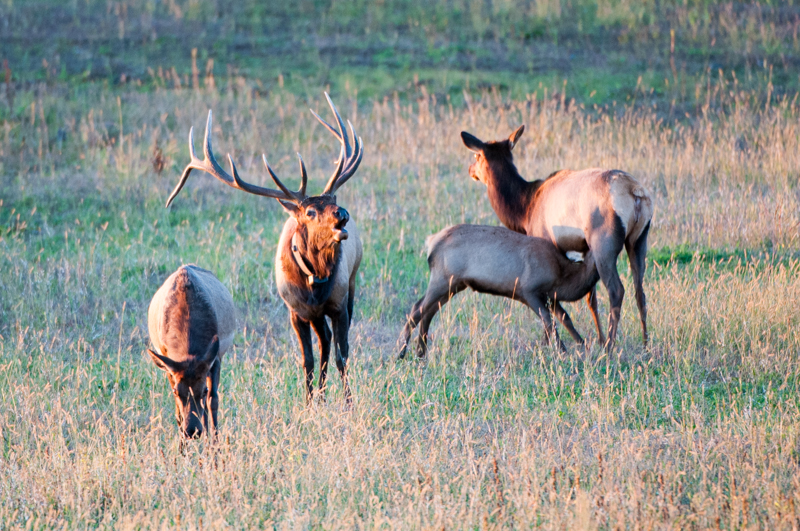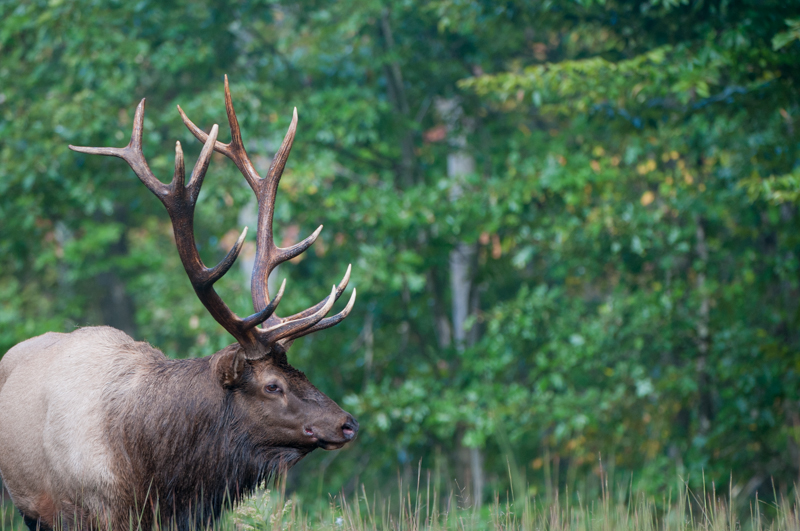Pennsylvania Elk Photography Experience #7 was a pure blast! We saw elk all over the place and bulls were everywhere! I cannot remember a year where we saw so many different bulls and most of them were in camera range. Many of us are spoiled, owning 200mm, 300mm, and even 400mm lenses. The big boy wildlife photographers even haul a 600mm lens out on the mountain!
I confess that lens envy is rampant in my photo circles. We always want more reach. Bigger lenses allow us to stay at a safe distance from the animals and still fill the frame with the subject we are photographing. The other related problem is lack of light in many lenses. Take, for example, the typical 70-300mm zoom lens that is often the second lens purchased by many photographers, it has reach but at 300mm the f-stop is a whopping f/5.6. That is simply not usable at dawn and dusk when animals are most visible and active. An f-stop of 2.8 is ideal, but many settle for f/4, which is a decent comprise to get the reach but also keep the lens affordable. The Nikon 400mm f/2.8 is $9,000!
My favorite lens for wildlife and sports photography is the 200-400mm f/4. I really like the zoom capability of this lens, especially for sports and wildlife. It allows me to zoom in and out from my position on the sidelines or on the mountain with the twist of the wrist. Typically I rest my left hand on top of the lens to be able to rotate the zoom mechanism when needed. Just remember, righty tighty, which zooms in closer, at least for the Nikon shooters.
I purchased the book, “How to Photograph Animals in the Wild,” by Lennie Rue III, and Len Rue, Jr. about 11 years ago. I got to meet them both twice–once at my favorite spot on the elk range behind my camp and once in a workshop they co-led here in the Poconos. Anyway, this book contains some of their incredible photographs. As I read the book and studied the photos, I saw a repeating trend: most of the photos were captured with a 200-400mm lens. Well, it then instantly became my dream lens. I saved for 3 1/2 years to purchase the lens and I use it every week. It really is a great lens for sports and wildlife photography, and it has quickly become my go-to lens!
Each of these photographs in today’s blog entry were captured with my 200-400mm f/4 lens. The lens is sharp and clear and it can be coupled with a teleconverter to provide even more reach if there is enough light. I also am now in the habit of carrying a second camera body around my body. This is necessary when photographing football games, so it comes quite naturally to me now. This week I carried the D300 with the 200-400mm f/4 on my tripod and another D300 with the 24-70mm f/2.8 around my body on an R-Strap. I also toted the Think Tank Belt System to carry my 70-200mm f/2.8 lens, my 50mm f/1.4 lens, my 1.4x teleconverter, and other accessories. It is all easy to carry and I am covered from 24mm all the way through 560mm. That’s pretty sweet for wildlife photography!
When we teach our photo classes for the Pennsylvania Elk Photography Experience, we recommend at least 200mm with a teleconverter. This covers out to 280mm and provides good minimal coverage for the large elk. For most other mammals, which are smaller, we recommend 300mm or more. A wildlife photographer can never seem to have enough lens reach!
Another helpful tip is getting close to the wildlife, or preferably, letting the wildlife get close to you. More on this topic next week. For now, just remember that lenses for wildlife might be expensive, but they sure produce consistently clear results. I really, really like my 200-400mm f/4 lens!
Now my next dream lens is the 400mm f/2.8 for football, and the 600mm f/4 for bird photography. It just never ends…



